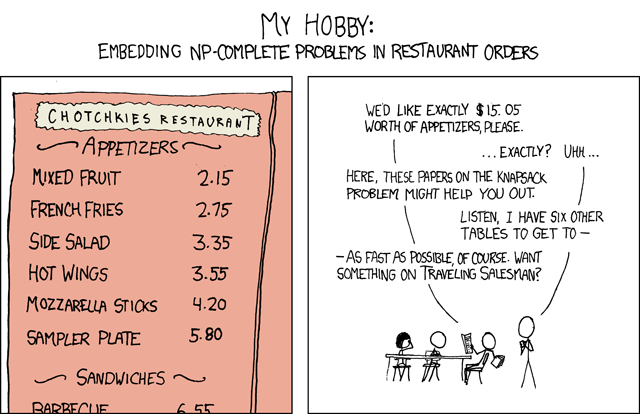The problem/comic in question: http://xkcd.com/287/

I'm not sure this is the best way to do it, but here's what I've come up with so far. I'm using CFML, but it should be readable by anyone.
<cffunction name="testCombo" returntype="boolean"> <cfargument name="currentCombo" type="string" required="true" /> <cfargument name="currentTotal" type="numeric" required="true" /> <cfargument name="apps" type="array" required="true" /> <cfset var a = 0 /> <cfset var found = false /> <cfloop from="1" to="#arrayLen(arguments.apps)#" index="a"> <cfset arguments.currentCombo = listAppend(arguments.currentCombo, arguments.apps[a].name) /> <cfset arguments.currentTotal = arguments.currentTotal + arguments.apps[a].cost /> <cfif arguments.currentTotal eq 15.05> <!--- print current combo ---> <cfoutput><strong>#arguments.currentCombo# = 15.05</strong></cfoutput><br /> <cfreturn true /> <cfelseif arguments.currentTotal gt 15.05> <cfoutput>#arguments.currentCombo# > 15.05 (aborting)</cfoutput><br /> <cfreturn false /> <cfelse> <!--- less than 15.05 ---> <cfoutput>#arguments.currentCombo# < 15.05 (traversing)</cfoutput><br /> <cfset found = testCombo(arguments.currentCombo, arguments.currentTotal, arguments.apps) /> </cfif> </cfloop> </cffunction> <cfset mf = {name="Mixed Fruit", cost=2.15} /> <cfset ff = {name="French Fries", cost=2.75} /> <cfset ss = {name="side salad", cost=3.35} /> <cfset hw = {name="hot wings", cost=3.55} /> <cfset ms = {name="moz sticks", cost=4.20} /> <cfset sp = {name="sampler plate", cost=5.80} /> <cfset apps = [ mf, ff, ss, hw, ms, sp ] /> <cfloop from="1" to="6" index="b"> <cfoutput>#testCombo(apps[b].name, apps[b].cost, apps)#</cfoutput> </cfloop> The above code tells me that the only combination that adds up to $15.05 is 7 orders of Mixed Fruit, and it takes 232 executions of my testCombo function to complete.
Is there a better algorithm to come to the correct solution? Did I come to the correct solution?
It gives all the permutations of the solutions, but I think I'm beating everyone else for code size.
item(X) :- member(X,[215, 275, 335, 355, 420, 580]). solution([X|Y], Z) :- item(X), plus(S, X, Z), Z >= 0, solution(Y, S). solution([], 0). Solution with swiprolog:
?- solution(X, 1505). X = [215, 215, 215, 215, 215, 215, 215] ; X = [215, 355, 355, 580] ; X = [215, 355, 580, 355] ; X = [215, 580, 355, 355] ; X = [355, 215, 355, 580] ; X = [355, 215, 580, 355] ; X = [355, 355, 215, 580] ; X = [355, 355, 580, 215] ; X = [355, 580, 215, 355] ; X = [355, 580, 355, 215] ; X = [580, 215, 355, 355] ; X = [580, 355, 215, 355] ; X = [580, 355, 355, 215] ; No The point about an NP-complete problem is not that it's tricky on a small data set, but that the amount of work to solve it grows at a rate greater than polynomial, i.e. there is no O(n^x) algorithm.
If the time complexity is O(n!), as in (I believe) the two problems mentioned above, that is in NP.
If you love us? You can donate to us via Paypal or buy me a coffee so we can maintain and grow! Thank you!
Donate Us With